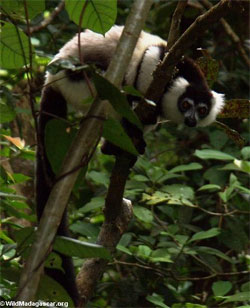Lemurs are key to health of Madagascar’s rainforests
Lemurs are key to health of Madagascar’s rainforests
Rhett A. Butler, mongabay.com
June 12, 2008
Lemurs play a key role in the health of Madagascar’s tropical rainforests said a renowned primatologist speaking at a meeting of conservation biologists in Paramaribo, Suriname.
Analyzing 20 years of data on lemur feeding habits in the forests of Ranomafana National Park, Dr. Patricia Wright found that entire genera of plant are dependent on a single species of lemur for dispersal. The results suggest that the loss of even a single species of lemur may threaten the survival of one or more plant species.
“The loss of one lemur species could threaten the persistence of a fruit family,” she told biologists at the annual meeting for the Association of Tropical Biology and Conservation (ATBC). “Forest composition depends on the entire community of lemurs. Therefore conservation must be at the community level.”

Black-and-white ruffed lemur. A survey in Malagasy in communities around Ranomafana revealed that respondents find this species the “tastiest”. |
Worryingly Wright noted that the “tastiest” lemur as revealed by surveys of more than 2000 individuals in local villages was also one of the most important dispersers: the black-and-white ruffed lemur.
Unlike other parts of the world where most seed dispersal is done by birds, rodents, ungulates, and bats, lemurs appear to be the most important seed dispersers in Madagascar. More than two-thirds of birds on the island are insectivores, as are most species of bats. No ungulates, possums, or squirrels are native to the forests of Madagascar.
Wright said future research in this area would focus on genetic tagging of fruits, tracking of seedlings, comparing feeding patterns across different sites in Madagascar, and mapping tree distribution within the forest.
“Lemurs are very important in Madagascar, now we’re trying to find out how important,” she concluded.







